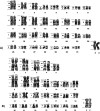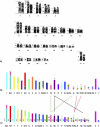The ancestral eutherian karyotype is present in Xenarthra
- PMID: 16848642
- PMCID: PMC1513266
- DOI: 10.1371/journal.pgen.0020109
The ancestral eutherian karyotype is present in Xenarthra
Abstract
Molecular studies have led recently to the proposal of a new super-ordinal arrangement of the 18 extant Eutherian orders. From the four proposed super-orders, Afrotheria and Xenarthra were considered the most basal. Chromosome-painting studies with human probes in these two mammalian groups are thus key in the quest to establish the ancestral Eutherian karyotype. Although a reasonable amount of chromosome-painting data with human probes have already been obtained for Afrotheria, no Xenarthra species has been thoroughly analyzed with this approach. We hybridized human chromosome probes to metaphases of species (Dasypus novemcinctus, Tamandua tetradactyla, and Choloepus hoffmanii) representing three of the four Xenarthra families. Our data allowed us to review the current hypotheses for the ancestral Eutherian karyotype, which range from 2n = 44 to 2n = 48. One of the species studied, the two-toed sloth C. hoffmanii (2n = 50), showed a chromosome complement strikingly similar to the proposed 2n = 48 ancestral Eutherian karyotype, strongly reinforcing it.
Conflict of interest statement
Competing interests. The authors have declared that no competing interests exist.
Figures



References
-
- Murphy WJ, Eizirik E, Johnson WE, Zhang YP, Ryder OA, et al. Molecular phylogenetics and the origins of placental mammals. Nature. 2001;409:614–618. - PubMed
-
- Murphy WJ, Eizirik E, O'Brien SJ, Madsen O, Scally M, et al. Resolution of the early placental mammal radiation using Bayesian phylogenetics. Science. 2001;294:2348–2351. - PubMed
-
- Springer MS, Stanhope MJ, Madsen O, de Jong WW. Molecules consolidate the placental mammal tree. Trends Ecol Evol. 2004;19:430–438. - PubMed
-
- Eizirik E, Murphy WJ, O'Brien SJ. Molecular dating and biogeography of the early placental mammal radiation. J Hered. 2001;92:212–219. - PubMed
Publication types
MeSH terms
Grants and funding
LinkOut - more resources
Full Text Sources

